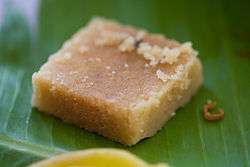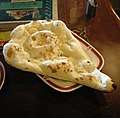Mysore pak
Mysore pak is an Indian sweet prepared in ghee. It originated in the city of Mysuru,[1][2] one of the major cities in the Indian state of Karnataka. It is made of generous amounts of ghee, sugar, gram flour, and often cardamom.[1] The texture of this sweet is similar to a buttery and dense cookie.[3]
 | |
| Course | Dessert |
|---|---|
| Place of origin | India |
| Invented | 1935 |
| Main ingredients | Ghee or oil, sugar, gram flour |

History
It is traditionally served in weddings and other festivals of southern India, and is very popular in baby showers as well.
The Maharaja of Mysore, Krishnaraja Wodeyar (1884–1940), was a food connoisseur and maintained a large kitchen at the Amba Vilas palace in Mysore to prepare different cuisines: from European, to the sacred prasadam or offerings to the various temples within the palace.
The origin of the dish is credited to his chief chef, Kakasura Madappa, who had not made any dessert. With time running out, the desperate Madappa began experimenting, wanting to present the King with something unusual. Adding gram flour, ghee and sugar, he made a soft pak (or mixture). This was presented on the royal thali as a hot, fudge-like sweet. The chef was called in and asked what the new dessert was called. He said the first thing that came to his mind - the 'Mysore pak'.
Paaka or extreme sweet, refers to the sticky sugar syrup obtained by simmering sugar with equal amount of water; specifically for Mysore pak, the simple syrup is heated to the soft ball stage. The syrup is used as the primary sweetening agent in various Indian sweet dishes like Jalebi, Badam puri, Mysore pak and others. The syrup is flavored with various spice essences like cardamom, rose, honey etc. Paaka syrup preparation is a skilled art mastered by few cooks, some of whom keep their methods secret.
Currently the hard "Mysore Pak" is slowly being replaced by softer Ghee version called "Mysurpa" the new age version of Mysore Pak. This was first launched by Shri Krishna Sweets and they held monopoly of the same for sometime and later it started occupying the shelves of every sweet shop in south india. Perhaps this is now the largest selling sweet in any big brand sweet stall in south India. With health conscious people trying to get rid of white sugar owing to its health perils, many sweet shops started offering "Karupatti Mysurpa" made out of palm sugar instead of white sugar. Lot of online websites are taking this delicacy across the globe.
In Chennai it is available online [4].
Attributes
- Shape: Mysore pak is cut into squares or rectangles.
- Texture: Hard and porous when made with less ghee, soft and dense when made with generous amount of ghee. Moisture from the sugar syrup escapes as steam through the greased gram-flour rendering Mysore pak porous. Excess ghee, if any, may fill in such pores rendering it dense.
- Colour: Yellow to light brown due to gram flour (roasted).
- Shelf life: Very little water is used in the preparation, so it can stay fresh in cool and dry place, but it should be used within one month only.
See also
References
- Mujumdar, Neha (24 November 2012). "In search of Mysore Pak" – via www.thehindu.com.
- "Four generations - mysore pak still crowd puller here" – via www.deccanchronicle.com.
- https://www.ndtv.com/south/how-the-famous-mysore-pak-was-invented-674512?amp=1&akamai-rum=off How the Famous Mysore Pak Was Invented
- https://noruku.trust.co.in/


